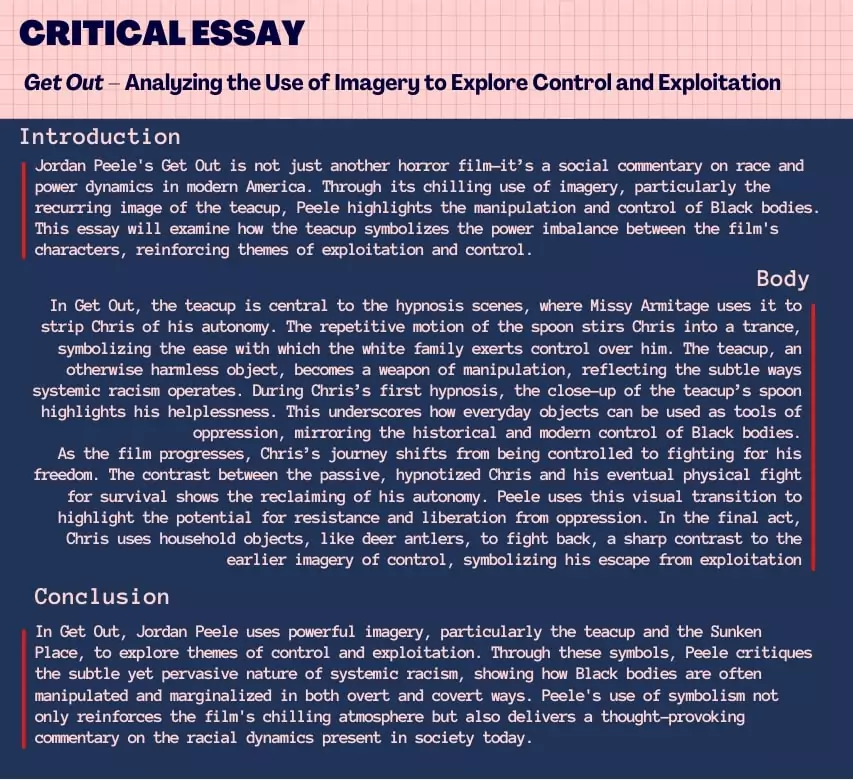How to Write a Critical Essay

Ever feel like you’re stuck staring at a blank screen, not sure how to start that critical essay your professor assigned? You’re not alone. Writing a critical essay can seem like a daunting task, especially when you’re not sure how to go beyond simply summarizing the material. But here’s the good news: once you understand the process, it’s a lot less intimidating than it sounds. This guide will walk you through how to write a critical essay step by step. By the end, you’ll have all the tools you need to turn your analysis into a well-structured and thoughtful paper without any stress.
What is a Critical Essay
If you ever wondered about how to critique something, a book, a film, or maybe even a research hypothesis, then the answer for you is – to write a critical essay about it. This type of writing revolves around the deep evaluation of the material in front of you. So, in such papers, the goal isn’t to say whether you liked something or not, but rather to analyze it based on evidence and logic. Think of it as taking a step back and asking, “What is really going on here?” and “How did the creator make that happen?”
In a critical essay, you start with a central claim or thesis that makes an argument about the material you’re analyzing. From there, you’ll support your points using evidence, like specific quotes from a book or scenes from a movie. And unlike casual conversations, this type of writing avoids personal opinions or judgments like “I liked it” or “It was boring.” Instead, you’re focused on breaking down the details and exploring themes, techniques, or strategies used by the creator.
For example, rather than saying “Charlie was so lucky to find a Golden Ticket” after watching Willy Wonka and the Chocolate Factory, a critical essay might explore how the film uses the contrast between wealth and morality to make a statement about society.
Writing a Perfect Critical Essay: Here’s What to Do
Writing a critical essay doesn’t have to be overwhelming if you approach it with a solid plan. Here’s a step-by-step breakdown of how you can structure your writing process to create a thoughtful, well-organized essay that impresses your readers (and earns you those high grades).
Choose and Fully Understand Your Topic
First things first—you need to select something to write about. This can be a movie, book, piece of music, or artwork. Just make sure it’s something you’re interested in and that you understand well. If your topic is assigned, spend time getting familiar with it. Watch the film or read the book a couple of times, and take notes on key themes, techniques, or elements that stand out.
Gather Your Sources
You’ll need evidence to support your analysis, so gather relevant material. Use scholarly sources like journal articles, books, and credible websites to back up your claims. The trick here is not just collecting information but understanding it. As such, if you’re writing about a novel, find analyses that discuss the author’s themes or techniques, and use that to build your argument. And remember to always keep track of your sources for proper citations later!
Develop a Strong Thesis Statement
Once you’ve done your research, it’s time to craft your thesis statement. This is the central argument of your essay, and everything you write should connect back to it. For example, if you’re analyzing the use of imagery in Get Out, your thesis might argue how the recurring image of the teacup symbolizes the control and manipulation of Black bodies in the film, reinforcing themes of power and exploitation. Keep your thesis specific, focused, and arguable ad it will carry your entire essay.
Create an Outline
Before you start writing, create an outline to organize your ideas. A typical critical essay includes an introduction, body paragraphs, and a conclusion. In the body, each paragraph should focus on a different point that supports your thesis. For instance, one paragraph might discuss symbolism, another might analyze character development, and a third could cover narrative techniques. Outlining helps you see the flow of your writing and make sure that each point has enough evidence to back it up.
Write the Body Paragraphs First
With your outline in place, begin writing the body paragraphs. Each paragraph should start with a topic sentence that introduces the main point, followed by evidence (quotes, examples, or facts) to support it. After presenting the evidence, analyze it and explain how it ties into your thesis. If you’re analyzing a movie, for example, you might focus one paragraph on how the director uses camera angles to create tension in a scene. Stay focused and make sure everything ties back to your central argument. You our free Essay Writer for optimal results.
Write the Conclusion
After finishing the body paragraphs, write the conclusion. This is where you sum up the key points of your essay and restate your thesis in light of the evidence you’ve presented. The conclusion should not introduce new information but instead reinforce your argument, leaving the reader with a clear understanding of your analysis.
Write the Introduction Last
Now that you’ve got the bulk of the essay written, it’s time to finally build the introduction. Start with a hook to grab the reader’s attention—a bold statement, an intriguing question, or a surprising fact can work well. Then, provide some background information to set the context for your analysis, and finish with your thesis statement that you have already created. Writing the introduction last allows you to make sure it aligns perfectly with the rest of your essay and clearly presents your argument.
Revise, Edit, and Proofread
You’ve got your first draft—congrats! Now, it’s time to bring it to perfection. Read through your essay a few times to improve clarity and flow. Check if all your points are well-supported and if your argument makes sense from start to finish. Edit for grammar, spelling, and style errors, and make sure all citations are correctly formatted. Taking this step seriously can make a huge difference in the overall quality of your essay (and in your grade as well).
Critical Essay Example: Proper Structure & Outline
Now, if you still feel kind of lost in all this information, don’t worry too much. Below you will find an example of what a well-organized critical essay can look like. Check it out to gain some inspiration and you will definitely be able to jump right into the writing process in no time at all.

FAQ
How should I start a critical essay?
To start a critical essay, begin with an engaging introduction that grabs the reader’s attention. You can use a hook, such as an interesting fact, a bold statement, or even a thought-provoking question. After the hook, provide some background information on the topic you’re discussing to set the stage. Finally, end the introduction with a clear thesis statement outlining the main argument or point you’ll analyze. This thesis will guide your essay and tell readers what to expect from your analysis.
What is a critical essay and example?
A critical essay is a type of writing where you analyze and evaluate a piece of work, such as a book, film, painting, or even a theory. This type of writing is dedicated to exploring the deeper meanings, strengths, weaknesses, and overall impact of its subject. For example, if you’re writing a critical essay about The Great Gatsby, you wouldn’t just summarize the plot—you’d dive into how F. Scott Fitzgerald uses symbolism and themes like the American Dream to convey larger messages.
What is the layout of a critical essay?
The layout of a critical essay usually follows a standard structure: an introduction, body paragraphs, and a conclusion. In the introduction, you present the topic and your thesis. The body paragraphs are where you break down the main points of your analysis, using evidence to support your claims. The conclusion ties everything together, summarizing your key points and restating your thesis in light of the evidence you’ve discussed.
What are the parts of a critical essay?
A critical essay has three main parts: the introduction, body paragraphs, and conclusion.
- Introduction: This is where you introduce the work you’re analyzing and present your thesis.
- Body Paragraphs: These are the meat of your essay, where you break down your analysis into different points, using evidence and examples to support your arguments.
- Conclusion: Here, you wrap up your analysis, summarizing the main points and reinforcing how they support your thesis.





